A Fast Image Restoration Method Based on an Improved
Criminisi Algorithm
Yue Chi1, Ning He2*, Qi Zhang1
1 Beijing Key Laboratory of Information Services Engineering, Beijing Union University, Beijing 100101,
China.
2 College of Information Technology, Beijing Union University, Beijing 100101, China.
* Corresponding author. Tel.: +86-138-1115-6835; email: xxthening@buu.edu.cn
Manuscript submitted April 18, 2016; accepted July 29, 2016.
doi: 10.17706/jcp.12.6.591-601
Abstract: This paper proposes an improved Criminisi image restoration algorithm that produces better
repairs and reduces the computational time. First, we improved the priority calculation and included a step
that transforms the original confidence term into an index to achieve a more precise repair. Second, in large
damaged areas of an image, we use a local searching method to find the optimal matching block to speed up
the repair process. Our experimental results show that the improved method significantly increased the
speed of the method, effectively retained image structures, and produced better visual effects.
Key words: Texture synthesis, image restoration, priority, local matching.
1. Introduction
Image restoration refers to reconstructing damaged images or removing excess. Bertalmio [1] first
proposed that image restoration can be reduced to a mathematical expression, which can then be
automatically solved using a computer. Image restoration has become a major research area in computer
graphics and computer vision. It has significant applications such as repairing cultural relics, film and
television post-production special effects, virtual reality, and removing unwanted objects. There are currently
two types of classic image repair techniques. The first uses structural rehabilitation methods such as the
BSCB model (M. Bertalmio-G. Sapiro-V. Caselles-C. Ballester, BSCB) [2], TV model (Total Variation, TV) [3], and
the CDD model (Curvature Driven Diffusion, CDD) [4]. TV models repair textural synthesis, and include the
Criminisi model. Structural rehabilitation methods require large numbers of calculations, are time consuming,
and result in more obvious blurring when considering large areas. Thus, they are more suitable for problems
such as small scratches and stains [5]-[8]. Textural synthesis repair methods use pixel block unit feature
extraction methods within a known area and select the best matching block. The synthesis is applied to the
damaged area and is more suitable for large areas [9].
In 2003, Criminisi et al. [10] proposed an image restoration method based on texture. The largest
restoration priority is given to a pixel block with a defect in the border of the source area. This method
searches for a block that is most similar to the current pixel block, and then uses it to replace the current
pixel block and complete the repair of the damaged area. This algorithm is based on block texture units but
not pixel units, so the repair is more time consuming. The algorithm can satisfactorily repair large damaged
areas, but the priority calculation and deficiencies in the matching block selection process can have a
negative impact on the repair.
Journal of Computers591Volume 12, Number 6, November 2017�
Many researchers have attempted to solve these disadvantages of the Criminisi algorithm. Bing et al. [11]
increased the border priorities to improve the method, and selected different parameters for different
types of images. These changes did improve the repair to some extent, but increased blurring. Wang et al.
[12] proposed a robust exemplar-based image repair method. Their model used a regularisation factor to
adjust the repair block priority function. They considered the SSD (sum of squared differences) of the
modified values and the NCC (normalised cross correlation) to search for the best matching block. This
method produced better repairs, but involves complicated calculations and is time consuming. Wong et al.
[13] proposed determining the matching blocks based on the varied degree of similarity between the block
and the block to be repaired. This algorithm can achieve an excellent repair, but it is time consuming and is
too dependent on the similarity of the repair block and sample blocks. In the same year, Lei et al. [14]
proposed a fast image restoration algorithm based on an adaptive template and the Criminisi algorithm. It
first considers the repair point gradients with respect to neighbouring pixels to effectively estimate the
point to be repaired. When considering the direction of the illumination line, the illumination
characteristics along the line to be repaired adaptively determine the size of the template. The algorithm
performs well with respect to edge details and smooth regions. For large areas, the repair will always be a
discontinuity. Zhou et al. [15] analysed the information structure that must be repaired with respect to the
intensity of the image block. Their improved algorithm can perfectly repair structural edges. These studies
were all based on the Criminisi algorithm and focused on repairing textural information.
In this paper, we propose an improved Criminisi priority calculation algorithm, which precisely restores
the confidence and image data using a joint decision image sequence. This method is quicker than existing
techniques, because it uses a local search method to find the optimal matching block. Our experimental
results show that the improved method significantly reduced the computational time and effectively
repaired the structure of the image.
2. Criminisi Algorithm
The Criminisi algorithm for texture synthesis is a classical algorithm for repairing large areas. It
combines the advantages of “texture synthesis” and “image repair” techniques. The basic principle of the
is an image containing a damaged area that we wish to repair,
Criminisi algorithm is shown in Fig. 1.
is the damaged area,
is the border region,
is a known source area of the image,
is a unit
pixel boundary,
is considered the centre of
, the target block.
is the tangential direction of the
illumination line and
is the damaged boundary tangent vector method.
Fig. 1. Basic schematic of the Criminisi algorithm.
The Criminisi algorithm is described as follows. We first calculate the priority of the block.
The priority depends on the combination of two values, the confidence
and the data
.
corresponds to the centre pixel (
) of the patch block (
), which is proportional to the original image. A
larger
corresponds to a greater priority, which reflects that a region containing more of the original
IPpPpIpn)(pC)(pD)(pCpp)(pCJournal of Computers592Volume 12, Number 6, November 2017�
information should be given priority.
represents the normal
, which belongs to the boundary
(
) of point
and the intact area of the product of the edge gradient vector,
. A larger value of
corresponds to a higher priority, which reflects that the boundary of the original patch has a
significant relationship with the structural strength, and should be given priority.
, where
The priority formula of the Criminisi algorithm is
is the confidence
term defined as
and
is the data term defined as
(1)
. (2)
Here,
is the area of the template
of
, that is, the total number of pixel template points.
is the confidence value for pixel point
, which must satisfy the initial conditions
. (3)
is the normalised factor;
=255×3 for a 24-bit RGB image.
Second, we search for the best matching block and use it for the repair.
The Criminisi algorithm is a global search method. It searches in undamaged areas for similar blocks to
use to repair the damage. To repair sample
, we use
and the sum of squares
difference
to find the colour of the sample with the minimum sum of squares difference,
which we use as the best matching module,
. The repair pixels in
are filled with the corresponding
pixels in
. This simultaneously repairs the textural information and structural characteristics. The
minimum sum of squares difference (SSD) is
and we calculate the colour sum of square differences using
, (4)
. (5)
Here, I and
correspond to pixel points in
and
, respectively.
Third, we update the confidence value. Each repair block is at the edge of the area to be repaired, and the
edges of the repair area constantly change after a texture block is repaired. When the highest priority target
block is repaired, its confidence is updated using
.
We repeat these three steps until the repair is complete.
The Criminisi algorithm performs well but it is time consuming, and the priority calculation and matching
)(pDpnpppI)(pD)()()(pDpCpP)(pC||)()()(pIqqCpCp)(pD||)(ppnIpD||ppp)(qCqqIqqC10)(pq),(qpcdqpq),(minargqpcqqd])()()[(),(222BBGGRRqpcIIIIIIdIpqpppCpC),()(Journal of Computers593Volume 12, Number 6, November 2017�
block selection are not optimal. The algorithm is based on the texture units of blocks rather than pixel units,
so it takes longer to repair large damaged areas. The priority calculation used to select areas and method of
finding matching blocks affect the texture of the damaged areas, which affects the accuracy.
Improved priority formulas can reduce the repair time. We propose using a local range search for the best
matching block to significantly improve the computational speed.
3. Improved Criminisi Algorithm
3.1. Priority Calculation
The key idea of the proposed algorithm is to consider restorative effects of the structure and the texture in
terms of the order of the repair blocks. The priority order must depend on two factors: the template
, and structural features around the area to be repaired, i.e., the data
window, i.e. the confidence
items
. The Criminisi algorithm’s priority formula is
. During the image
restoration process, the confidence gradually reduces to zero, leading to incorrect filling orders. We
propose using the priority
, where
. According to (1), a larger undamaged
proportion of the block to be repaired corresponds to a larger confidence. According to (2), if the filling
point
is nearer the edge,
is larger and the angle between
and
is smaller. Then,
is larger and the area will be repaired sooner. The light intensity of portions of the image’s linear structure
determines the size of data items. Edges of the image are repaired first to retain the structure and reduce
has more of an influence on the priority. The image edges and gradients reflect
diffusion. Therefore,
the image texture features. Pixels with large gradients represent a rich textured image. To increase the
gradient transform (that is, increase the influence of
by weakening
), we set
.
Then,
, the confidence decreases, and the importance of the data items increases. This
improves the textural details, and increases the accuracy of the repair. In our experimental results, when
gradually increased from 2 the repair was more effective, the optimal results where for
, and the
result was inaccurate when
=5.
3.2. Local Area Search for the Optimal Matching Block
The original Criminisi algorithm searches the entire image to find the most similar block. But many similar
blocks are in the vicinity of the target area, so a global search reduces the efficiency of the algorithm. To
reduce the search space and achieve satisfactory repairs, we use a local area search.
Fig. 2. Local search for matching block.
Fig. 2 shows an image containing a damaged area.
is the damaged area,
is the border region,
)(pC)(pD)()()(pDpCpP)()()(pDpCpP1ppIpIpn)(pD)(pD)(pD)(pC1||)()()(pIqqCpCp)()(pCpC3Journal of Computers594Volume 12, Number 6, November 2017�
is a known source area,
is a unit pixel boundary, and
is the centre of
(the target block).
is the tangential direction of the illumination line, and
is the damaged boundary tangent vector.
In the Criminisi algorithm, we set the block size of the patch (red box) to a 9×9 pixel block, and search
through all the matching blocks in the entire undamaged area. This is time consuming, and reduces the
repair efficiency. However, the most similar blocks are typically located in the general vicinity of the block to
be repaired. We determine the pixel with the highest priority, and then extend down 13 pixels (i.e., in a local
27×27 pixel block). With this in mind, the proposed method uses a local search block matching method to
solve the original Criminisi algorithm and reduce the computational time.
Fig. 2 shows the basic principles of the local search method. It uses the following steps.
1) The current pixel has the highest priority. Extend down 13 pixels, within the scope of a partial 27×27
pixel block to find the best matching block.
2) Search within the 27×27 pixel block using a 9×9 sample template. That is, start in the upper left corner
from the first point, and using a 9×9 pixel template traverse from left to right, down one line, and continue
to traverse from left to right, until you have traversed all the pixels.
3) After repairing this section of the image using the best matching block, update the boundary
information and return to Step (2) until the entire image is repaired.
4. Results and Analysis
We ran our experiment using a 3.4GHz processor, 8GB of memory, and MATLAB R2010b.
We applied the algorithm to natural and character image restoration, and single and multitarget removal,
to illustrate its adaptability and robustness. The image dimensions were 100×100, 350×262, 371×432 before
applying the algorithm and the images were jpg files. After applying the algorithm, the image dimensions
were 256×256, 512×512, and there were two groups.
We evaluated our algorithm in terms of the computational time and the peak signal to noise ratio (PSNR),
that is,
,
where MSE represents the difference between the original and restored image [16]-[19]. If
are the
original pixel values,
are the repaired the pixel values, and
is the number of pixels,
.
Although PSNR is not a standard evaluation for small-scale defect image restoration, it can reflect the effect
of the repair [20]-[23].
4.1. The Improved Algorithm Results before and after Comparison and Analysis
Fig. 3 illustrates the results when repairing a manual obstruction. The image has a simple structure and
minimal colours, so the results of the two algorithms are similar. Fig. 4 shows the removal of some targets
from an image. The image had many targets that were distributed across regions of different colours, so this
image was more difficult to repair [24]. The Criminisi algorithm’s result was not ideal; there were green
pixels throughout the blue lake area. The results of the proposed algorithm were more successful. Fig. 5
contains a scratch. The results obtained by Criminisi algorithm showed an affective background repair, but
there were white lines on the image due to the scratches. The proposed algorithm produced better results.
PpPpIpn)255lg(102MSEPSNRiIiJNNJIMSENiii12)(Journal of Computers595Volume 12, Number 6, November 2017�
Table 1 compares the run times of the algorithms. The computational time of the proposed algorithm
depended on the size of the image, but was significantly less that the original algorithm. The proposed
algorithm performed better in terms of the PSNR than the Criminisi algorithm (Table 2), and produced better
visual improvements.
(a) Original (b) Damaged (c) Criminisi (d) This paper
Fig. 3. Image repair for a subjective obstruction.
(a) Original (b) Damaged (c) Criminisi (d) This paper
Fig. 4. Multitarget removal.
(a) Original (b) Damaged (c) Criminisi (d) This paper
Fig. 5. Photo restoration to remove crease.
Fig. 2
Fig. 3
Fig. 4
Table 1. Comparison of Running Times
Image size
100×100
350×262
371×432
3663.980
3372.670
Criminisi/s
38.531
This paper/s
3.364
36.338
30.819
Table 2. Comparison of Peak Signal to Noise Ratio
This paper
30.903
23.128
32.367
Fig. 2
Fig. 3
Fig. 4
Image size
100×100
350×262
371×432
Criminisi
29.148
21.931
31.030
4.2. Experimental Results Compared to Control and Analysis
To demonstrate the effectiveness of the improved algorithm, we compared it with the Criminisi algorithm,
TV algorithm, and MCA algorithm [25], [26]. We considered edge restoration, regular texture restoration,
checkerboard mask corrosion restoration, and striped mask corrosion restoration. We used the program
running time and peak signal to noise ratio (PSNR) to measure the efficiency of the algorithm. In our control
experiments, we set the TV model algorithm [27], [28] to use 500 iterations.
4.2.1. Analysis of edge and regular texture regions
The edge and regular texture areas restoration experiments verified that the improved algorithm can
Journal of Computers596Volume 12, Number 6, November 2017�
effectively maintain object connectivity and compliance in terms of a subjective evaluation. The edges of
Fig. 6–Fig. 9 show that the proposed method and the Criminisi algorithm outperformed the other algorithms.
The PSNRs for the proposed method were higher and a visual evaluation shows that the repair was the most
effective. The TV algorithm result is partially smoothed and has poor connectivity (Fig.6), and breaks some
edges (Fig. 7) producing obvious blurring. The MCA algorithm was time consuming and did not produce
optimal results. In Fig. 6, we can see that the MCA distorted the image. For the regular texture repair
examples, the proposed method produced better results and more completely restored the image, while the
other three methods have varying degrees of defect.
Original Damaged Criminisi TV MCA This paper
Fig. 6. Repairing edges (boat).
Original Damaged Criminisi TV MCA This paper
Fig. 7. Repairing edges (hat).
Table 3. Comparison of Running Times
Fig. 6
Fig. 7
Image size
256×256
256×256
Damaged size
Criminisi/s
50×50
50×50
1.342
1.893
TV/s
2.414
3.089
MCA/s
2.711
3.289
This paper/s
0.928
1.034
Fig. 6
Fig. 7
Image size
256×256
256×256
Table 4. Comparison of Peak Signal to Noise Ratio (PSNR)
MCA
20.848
20.819
Criminisi
21.842
22.277
TV
20.972
21.082
Damaged size
50×50
50×50
This paper
23.114
23.109
Original Damaged Criminisi TV MCA This paper
Fig. 8. Repairing regular texture regions (table cloth).
Original Damaged Criminisi TV MCA This paper
Fig. 9. Repairing regular texture regions (brick).
Table 5. Comparison of Running Timed
Image size
Damaged size
Criminisi
TV
Fig. 8
Fig. 9
256×256
256×256
50×50
50×50
1.209
1.343
2.014
2.189
MCA
2.431
2.389
This paper
0.312
0.294
Journal of Computers597Volume 12, Number 6, November 2017�
Table 6. Comparison of Peak Signal to Noise Ratio
Fig. 8
Fig. 9
Image size
256×256
256×256
Damaged size
50×50
50×50
Criminisi
21.106
20.934
TV
19.072
19.142
MCA
18.712
18.803
This paper
22.487
22.675
4.2.2. Checkerboard and Stripe Mask Image Restoration
Our checkerboard and striped mask corrosion restoration experiments verified that the improved
algorithm can effectively restore the complex structure of an image in a subjective evaluation. The results for
the checkerboard mask are shown in Fig. 10 and Fig. 11, and the results for the striped mask are shown in
Fig. 12 and Fig. 13. The proposed algorithm produced the best results in terms of the PSNR and a visual
evaluation. The checkerboard results in Fig. 10 and Fig. 11 are relatively similar, but the proposed algorithm
performs subjectively better. The striped mask results in Fig. 12 and Fig. 13 show a large loss in image
information, so the repairs were challenging. Our results show that the other three methods produce
blurring. The eyes and mouths in the Lena and Barbara images are not clear. However, the proposed method
effectively restored the image information, and the results had a high signal to noise ratio.
Original Damaged Criminisi TV MCA
This paper
Fig. 10. Repairing an image with a checkerboard mask (Lena).
Original Damaged Criminisi TV MCA This paper
Fig. 11. Repairing an image with a checkerboard mask (Barbara).
Table 7. Comparison of Running Time
MCA/s
TV/s
Fig. 10
Fig. 11
Image size
512×512
512×512
Criminisi/s
3899.273
3903.142
1731.892
1756.231
2350.692
2397.811
This paper/s
50.331
51.255
Table 8. Comparison of Peak Signal to Noise Ratio
Fig. 10
Fig. 11
Image size
512×512
512×512
Criminisi
24.831
24.665
TV
24.095
24.243
MCA
24.355
23.536
This paper
25.844
25.682
Original Damaged Criminisi TV MCA This paper
Fig. 12. Repairing an image with a striped mask (Lena).
Journal of Computers598Volume 12, Number 6, November 2017�
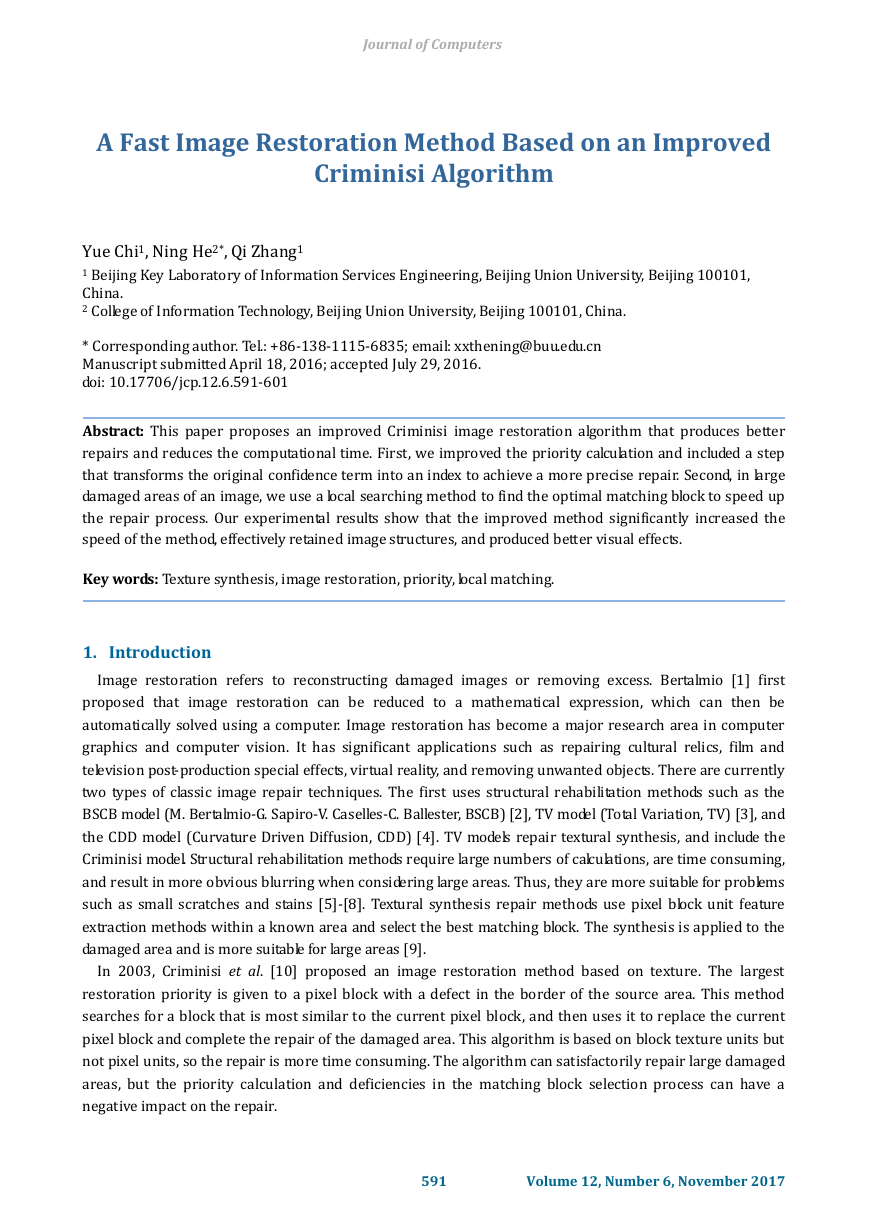
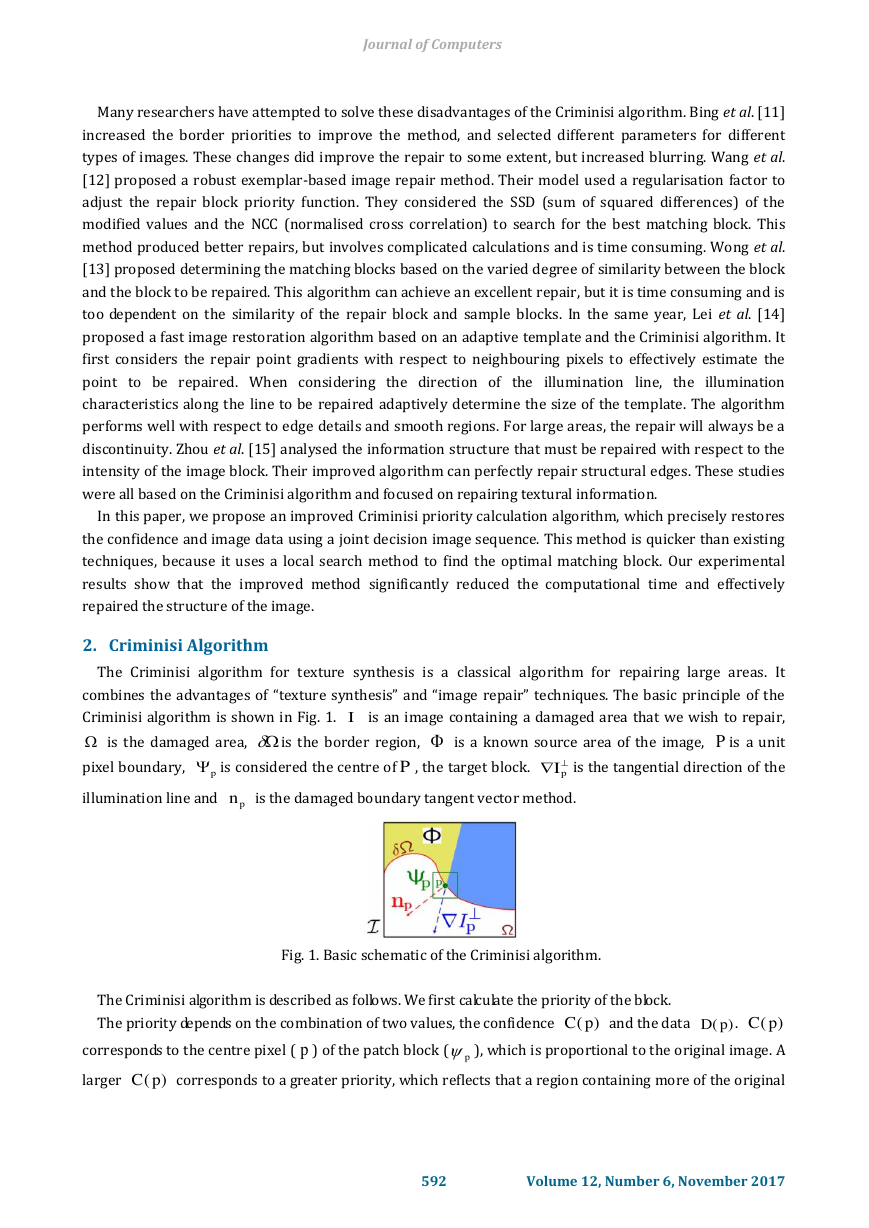

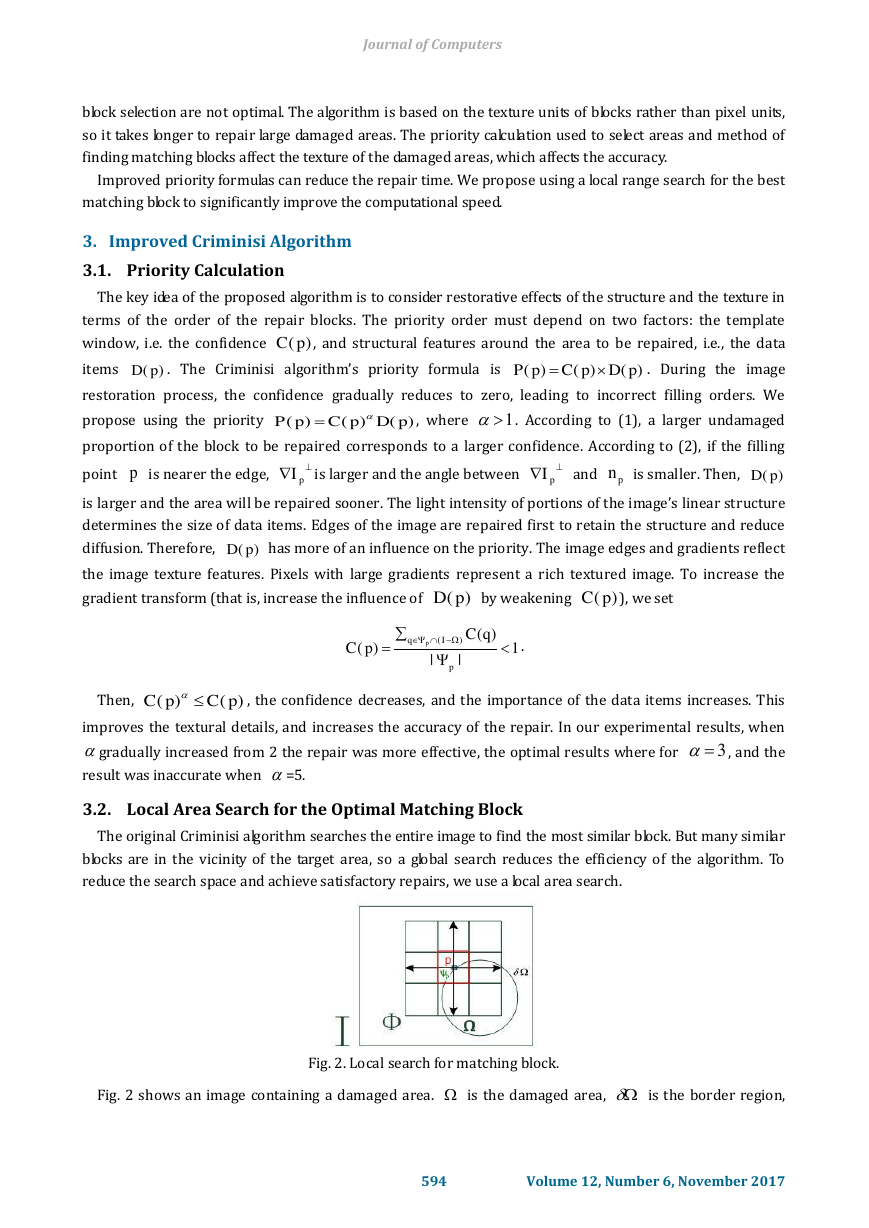
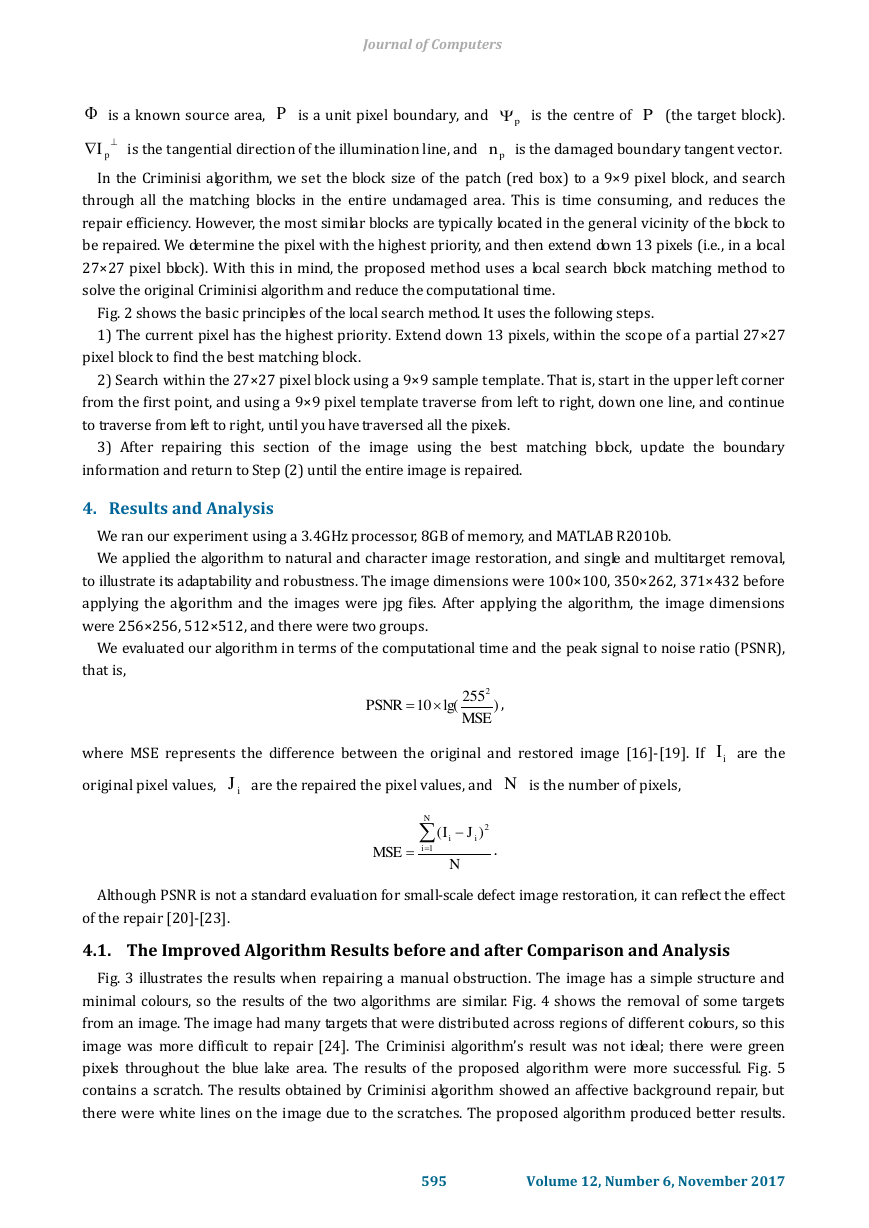
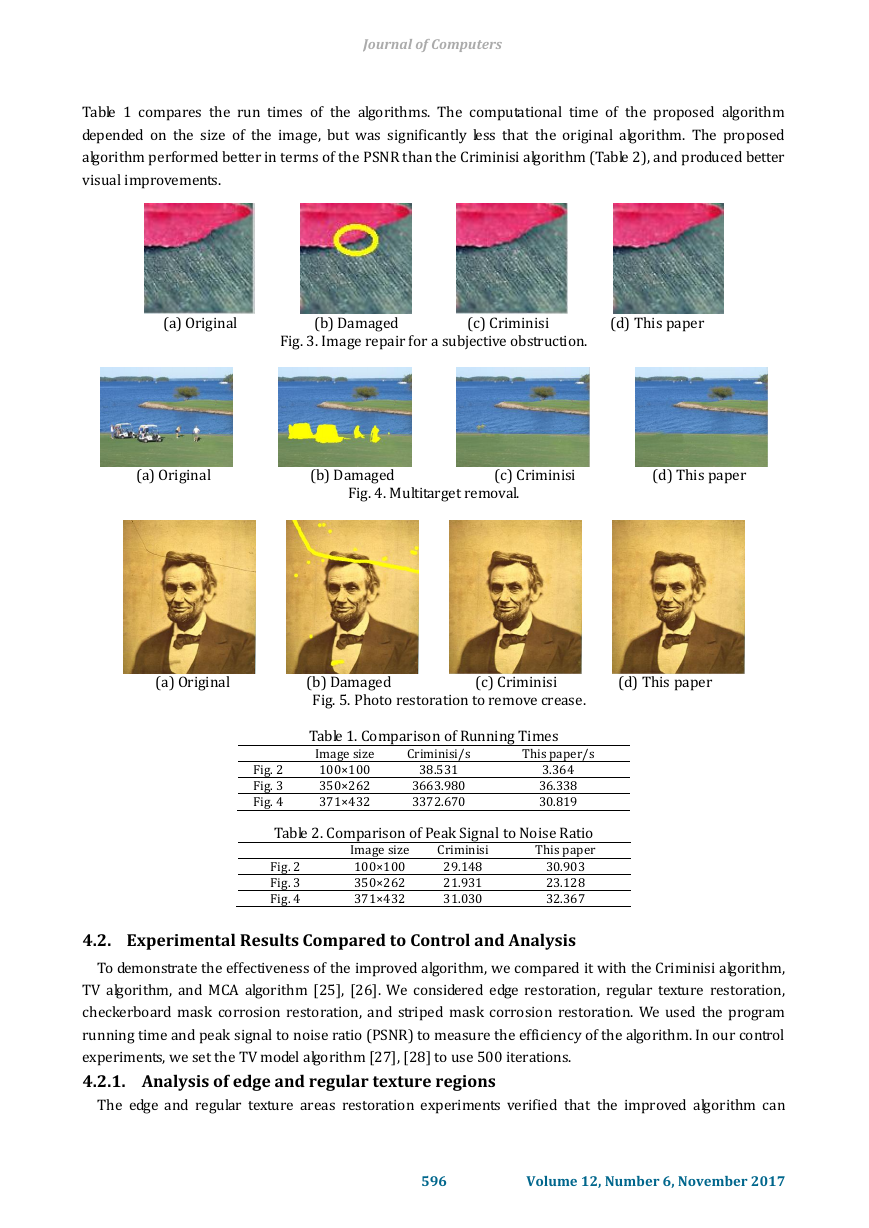
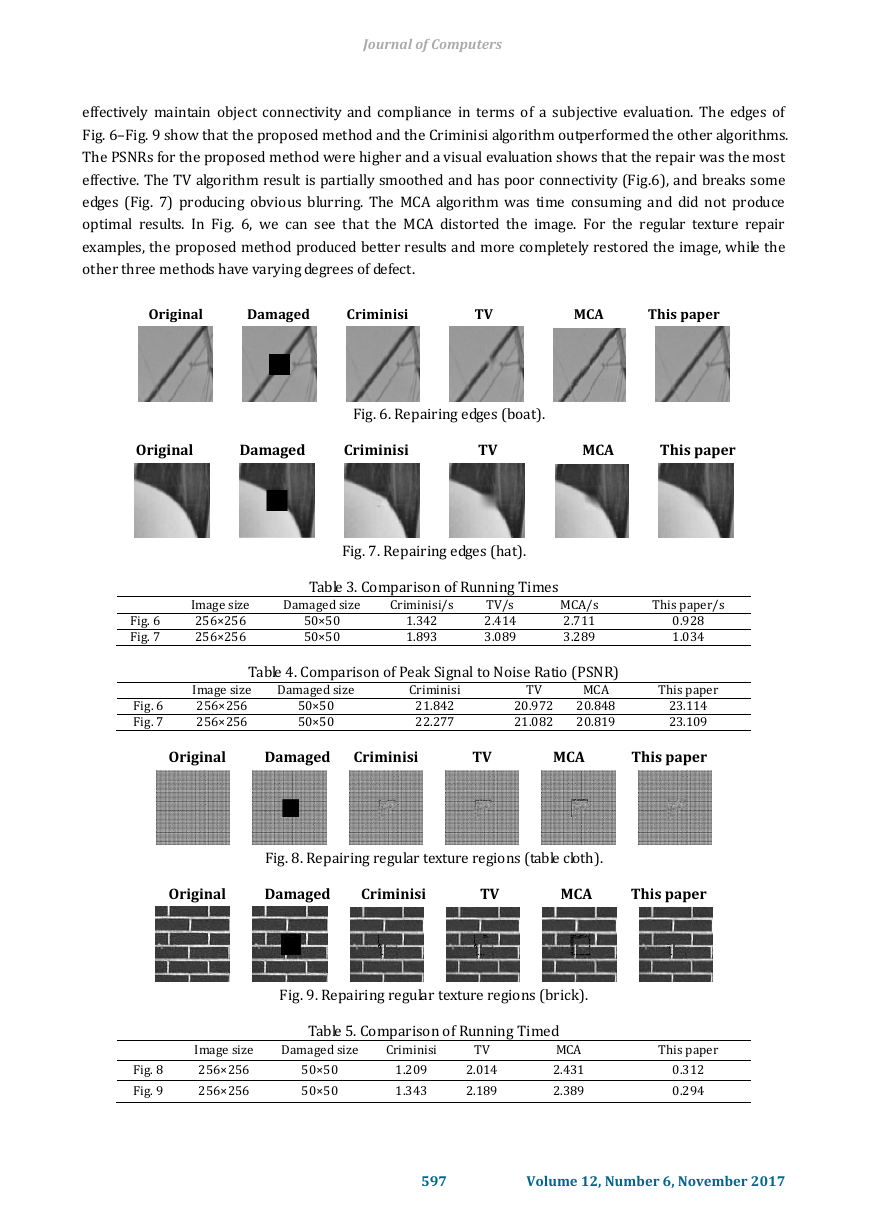
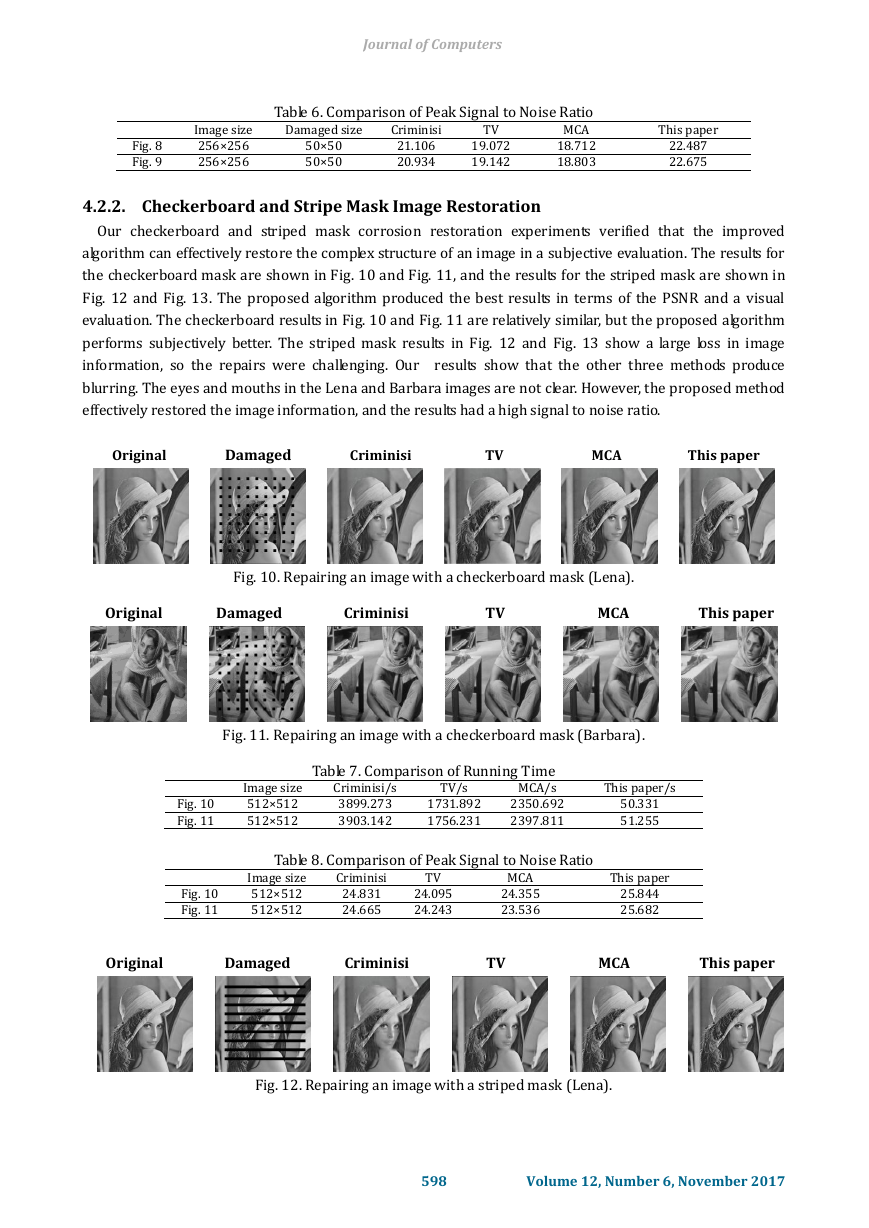








 2023年江西萍乡中考道德与法治真题及答案.doc
2023年江西萍乡中考道德与法治真题及答案.doc 2012年重庆南川中考生物真题及答案.doc
2012年重庆南川中考生物真题及答案.doc 2013年江西师范大学地理学综合及文艺理论基础考研真题.doc
2013年江西师范大学地理学综合及文艺理论基础考研真题.doc 2020年四川甘孜小升初语文真题及答案I卷.doc
2020年四川甘孜小升初语文真题及答案I卷.doc 2020年注册岩土工程师专业基础考试真题及答案.doc
2020年注册岩土工程师专业基础考试真题及答案.doc 2023-2024学年福建省厦门市九年级上学期数学月考试题及答案.doc
2023-2024学年福建省厦门市九年级上学期数学月考试题及答案.doc 2021-2022学年辽宁省沈阳市大东区九年级上学期语文期末试题及答案.doc
2021-2022学年辽宁省沈阳市大东区九年级上学期语文期末试题及答案.doc 2022-2023学年北京东城区初三第一学期物理期末试卷及答案.doc
2022-2023学年北京东城区初三第一学期物理期末试卷及答案.doc 2018上半年江西教师资格初中地理学科知识与教学能力真题及答案.doc
2018上半年江西教师资格初中地理学科知识与教学能力真题及答案.doc 2012年河北国家公务员申论考试真题及答案-省级.doc
2012年河北国家公务员申论考试真题及答案-省级.doc 2020-2021学年江苏省扬州市江都区邵樊片九年级上学期数学第一次质量检测试题及答案.doc
2020-2021学年江苏省扬州市江都区邵樊片九年级上学期数学第一次质量检测试题及答案.doc 2022下半年黑龙江教师资格证中学综合素质真题及答案.doc
2022下半年黑龙江教师资格证中学综合素质真题及答案.doc